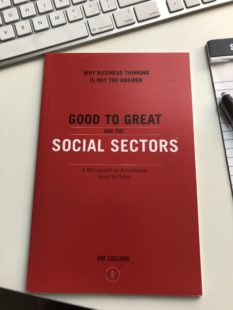Books to Read: Good to Great and the Social Sectors
 Many years ago, I read Jim Collins’ book Good to Great and I found it interesting. However, I must admit, beyond the continuing use of the phrase “getting the right people on the bus”, I hadn’t heard or thought of it for some time. Then, a client asked me to use the companion monograph to facilitate a leadership retreat for her team. She wanted to use it for two reasons. First, she appreciates the idea of the Hedgehog Concept. Second, she wanted her staff to develop a common language about their work. Like my client, I found the monograph worth the re-reading.
Many years ago, I read Jim Collins’ book Good to Great and I found it interesting. However, I must admit, beyond the continuing use of the phrase “getting the right people on the bus”, I hadn’t heard or thought of it for some time. Then, a client asked me to use the companion monograph to facilitate a leadership retreat for her team. She wanted to use it for two reasons. First, she appreciates the idea of the Hedgehog Concept. Second, she wanted her staff to develop a common language about their work. Like my client, I found the monograph worth the re-reading.
What I appreciated about the monograph is the way Collins reframed some of the key components of his original work to take into account the fact that “social sector leaders [face] realities they perceive to be quite different from the business sector.” (p.3) He identified five as the focus of the monograph and for the most part, I think he has reimagined the components of Good to Great appropriately though I do have a couple of places where I think he missed an opportunity.
Mission and greatness
The first component addresses the basic concern of most social sector leaders – how do you define great in the social sector? His answer is one I agree with even though I was several years into my career before I understood it. Collins defines it this way, “For the social sector, however, performance must be assessed relative to mission, not financial returns….’how effectively do we deliver on our mission and make a distinctive impact, relative to our resources?'” (p.5)
I appreciate a related change in the monograph. In the book, the idea that leads to getting the right people on the bus is “First who, then what.” Apparently, in the business world, it doesn’t really matter what you are doing, as long as you have the right people. Once you have them, you have the ability to figure out what to do. In the monograph, the idea is modified to “First who”. Collins puts it this way, “…the number-one resource for a great social sector organization is having enough of the right people willing to commit themselves to mission.” (p.16-17) He has several examples, but the critical idea here is the importance of a clear understanding of the organization’s mission. The mission is what powers that proverbial bus.
Great leaders, not great power
Collins identifies another difference between the business and social sectors – the style of leadership needed to be effective. He describes the relevant style of leadership as legislative rather than executive. However, he still shows the same leadership pyramid with “Level 5 Executive” leadership at the top. Level 5 Leadership is described as “builds enduring greatness through a paradoxical blend of personal humility and professional will.” (p. 12) I think he missed an opportunity here. Such leadership should and can exist throughout an organization and social sector organizations often lead the way here. He would have done well to eliminate the pyramid image.
As I said in the beginning, it had been a while since I had read either the book or the monograph. However, in reading the monograph to prepare for leading a retreat, I found much to appreciate. That’s why I recommended it to another client for work with his leadership team and I’m recommending it here to you as well. Clarity of mission, directed purpose, and leaders who are committed to the work, Collins has much to say to social sector organizations. His monograph is well worth the read.
Collins, J. (2005). Good to Great and the Social Sectors: A Monograph to Accompany Good to Great, Jim Collins: Boulder.
